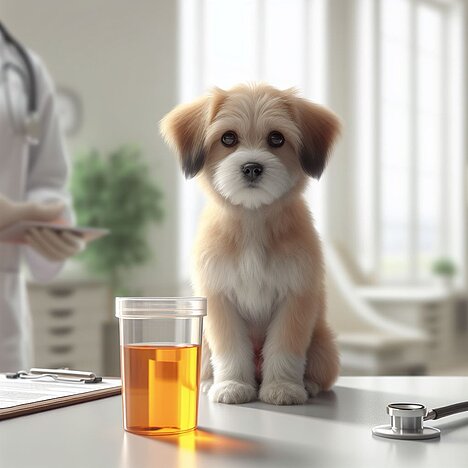Chondrodysplasia

Chondrodysplasia is a disease that affects the development of bones and cartilage in dogs. It can lead to various symptoms such as short stature, joint problems, spinal deformities and pain. In this blog post, you can find out more about the causes, diagnosis and treatment options for chondrodysplasia in dogs.
What is chondrodysplasia?
Chondrodysplasia is a generic term for various genetic disorders that prevent or disrupt the formation of bone and cartilage. These disorders can be inherited in either an autosomal recessive or autosomal dominant manner. This means that a dog must inherit either two defective genes from both parents or one defective gene from one parent in order to develop the disorder.
The bones and cartilage are important parts of the skeletal system that give the body stability and mobility. The bones consist of a hard outer part, the cortical bone, and a soft inner part, the medulla. The cartilages are flexible tissues that cover the ends of the bones and act as shock absorbers between the joints. The bones and cartilage grow through a process called ossification, in which special cells called chondrocytes transform into osteoblasts and form bone tissue.
In dogs with chondrodysplasia, this process is disrupted, resulting in insufficient or abnormal ossification. This can cause the bones to become too short, too thin or too brittle. The cartilage can also be affected and become too thick or too thin. The result is a deformation of the skeleton, which can vary depending on the severity and the parts of the body affected.
What are the symptoms of chondrodysplasia?
The symptoms of chondrodysplasia can vary depending on the type of genetic disorder, the age of the dog and the extent of the skeletal deformity. Some of the most common symptoms are:
- Short stature: dogs with chondrodysplasia often have a shorter height than normal. This may affect all four limbs or just the front or hind legs. The paws may also be smaller than normal.
- Joint problems: Dogs with chondrodysplasia may suffer from arthritis, an inflammation of the joints that causes pain, swelling and stiffness. This can affect the dog's mobility and quality of life.
- Spinal deformities: Dogs with chondrodysplasia may have an abnormal curvature of the spine called scoliosis. This can lead to back pain, nerve compression and neurological problems.
- Breathing problems: Dogs with chondrodysplasia may have a narrowing of the airway called brachycephaly. This can lead to snoring, panting, coughing and shortness of breath.
- Eye problems: Dogs with chondrodysplasia may have a change in the shape of the eye called exophthalmos. This can lead to dryness, irritation, inflammation and infection of the eyes.
Which breeds are prone to chondrodysplasia?
Chondrodysplasia is a hereditary condition that affects certain breeds more often than others. Some of the breeds that are predisposed to chondrodysplasia are:
- Basset Hound
- Beagle
- Dachshund
- French Bulldog
- Pug
- Pekingese
- Scottish Terrier
- Shih Tzu
These breeds often have a characteristic appearance called "achondroplasia type". This means that they have short legs, a long body, a large head and a flat muzzle. This appearance is the result of selective breeding that promotes the expression of a specific gene responsible for chondrodysplasia. This gene is called fibroblast growth factor receptor 3 (FGFR3) and regulates bone ossification.
However, there are other forms of chondrodysplasia that involve other genes and can affect other breeds. Some examples are
- Grebe type chondrodysplasia: This form mainly affects the Norwegian Lundehund and results in shortening of the limbs, enlargement of the paws and polydactyly (more than five toes per paw).
- Chondrodysplasia of the Schmid type: This form mainly affects Labrador retrievers and leads to a shortening of the limbs, a widening of the chest and a thickening of the cartilage.
- McNab type chondrodysplasia: This form mainly affects the McNab Shepherd and results in shortening of the limbs, widening of the skull and deformation of the spine.
How is chondrodysplasia diagnosed?
The diagnosis of chondrodysplasia is based on a combination of clinical signs, breed history, physical examination and imaging techniques. A veterinarian may take the following steps to diagnose the condition:
- Obtain a medical history: The veterinarian will ask questions about the dog's age, breed, sex, ancestry and symptoms. This can help determine the likelihood of a genetic disorder.
- Perform a physical examination: The veterinarian will examine the dog for signs of short stature, joint problems, spinal deformities, breathing problems and eye problems. He will also measure and compare the length, girth and shape of the limbs.
- Use imaging techniques: The veterinarian may use radiographs, ultrasound or computed tomography (CT) scans to assess the structure and density of the bones and cartilage. This can help determine the degree of ossification disorder.
- Perform genetic testing: The veterinarian may take a blood sample or a tissue sample and send it to a lab to look for the presence of mutations in the genes responsible for chondrodysplasia. This can help to identify the type of genetic disorder.
How is chondrodysplasia treated?
The treatment of chondrodysplasia depends on the severity of the symptoms and the general condition of the dog. There is no cure for the condition, but there are ways to improve the dog's quality of life and prevent complications. Some of the possible treatment options are:
- Pain medication: the vet may prescribe non-steroidal anti-inflammatory drugs (NSAIDs) or opioids to relieve the pain and inflammation in the joints. However, these drugs must be used with caution as they can cause side effects such as stomach ulcers or kidney damage.
- Physiotherapy: The vet may recommend a range of exercises.
The authors assume that a veterinarian should be consulted if an animal is ill and that medication should only be taken after consultation with a doctor or pharmacist. Only an individual examination can lead to a diagnosis and treatment decision.
We help you find the nearest vet → This way